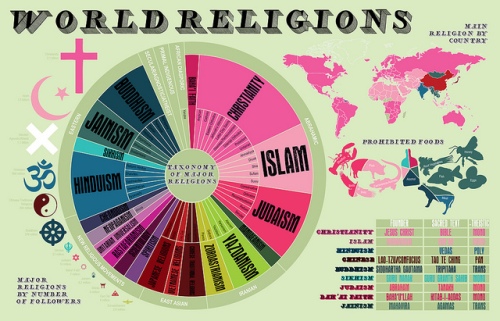 This “world religions” infographic is so interesting because it clearly demonstrates the Western-centricity of our modern taxonomy of “religion”. First we have the large pie chart on the left. It’s outer circle gives a rather disparate group of large categories. Most of these are vague geographic categories (East Asian, Eastern, African Diasporic, Iranian), but “Abrahamic” gets its own category. This implies “Abrahamic” is a category of the same level as “East Asian”. However, “European” or “Germanic” etc. would be more appropriate category. Thus Abrahamic religions are united into one category while that same unity is denied other parts of the world. Furthermore, the very diverse indigenous traditions from (non-literate) peoples across the globe all get lumped into the single category of “Primal Indigenous”.
This “world religions” infographic is so interesting because it clearly demonstrates the Western-centricity of our modern taxonomy of “religion”. First we have the large pie chart on the left. It’s outer circle gives a rather disparate group of large categories. Most of these are vague geographic categories (East Asian, Eastern, African Diasporic, Iranian), but “Abrahamic” gets its own category. This implies “Abrahamic” is a category of the same level as “East Asian”. However, “European” or “Germanic” etc. would be more appropriate category. Thus Abrahamic religions are united into one category while that same unity is denied other parts of the world. Furthermore, the very diverse indigenous traditions from (non-literate) peoples across the globe all get lumped into the single category of “Primal Indigenous”.
Moving into the middling circles of the pie chart, we have these large categories of Christianity, Islam, Hinduism, etc. And as subcategories of each of this large religions, we have different denominations such as “Unitarian Christianity” or “Shia Islam”. Yet looking over to East Asia, we have “Japanese religions”, “Vietnamese religions”, “Chinese religions”. So again, we have the false equivalency of Western religious systems with geographic designations. Strangely, Buddhism does not count as a Japanese religious sect at all, despite the unique form of Buddhism that developed in Japan and had a deep influence upon of Buddhism was understood in the West. In other words, so-called “original” Buddhism “re-discovered” by Westerners is privileged over the actual Buddhist practices of people in China, Japan, and South-East Asia.
To the left of the pie chart, there are various symbols of religions scaled to size relative to the number of followers of each religion. This brings up another problem: how does one define a “follower” of a religion. For the two largest, Christianity and Islam, these religions require a confession of faith, so it is relatively easy. But what about Judaism? Are you Jewish only if you confess you are Jewish on surveys? Or are you Jewish by birth or by ethnicity? No doubt this infographic used data based on self-reported adherence to religion. But then look at the example of Japan. Majority of Japanese people self-identify as atheists or non-religious on surveys, but a majority also participate in Buddhist/Shinto ritual. Do we count them as followers of Buddhism or Shinto? Even the idea of being a “follower” of religion is not indigenous to many countries.
Moving away from the pie chart, we have a world map (with of course Europe positioned in the center) that shoes most the world dominated by “Abrahamic” religions. Of course, China is coloured “Chinese religions” and Japan is coloured “Japanese religions”. Strangely, no nations seems to be coloured Buddhism. So this map reproduces the issues of categories some religions by geography and some by historical roots, which I pointed out above. This causes the visual map to overemphasize the unity of “Abrahamic religions” and underemphasize the similarities between Asian religious practices.
Underneath the map is a prohibited foods graphic. Actually I have never seen something like this before and think it is quite clever. It does, however, position eating restrictions as a defining characteristic of generic “religion”.
The last chart in the lower righthand corner is the most obviously problematic section of the graphic. It lists nine of the religions along with their founder, sacred text, and “-theistic” type. Christianity naturally comes first, because of it is model for generic religion. The problem with this chart, is it positions these three characteristics (based on how Christianity has defined itself) as essential aspects to =all= religions, which is frankly untrue. It leads to people thinking that a certain book or person is essential to a religion, when in practice that book/person was little esteemed by actually practitioners of the religion/tradition. For example, classical texts like the Tao Te Ching have little relevance to the actual practice of Chinese (folk) Taoism. Furthermore, this chart lists both Lao-tzu and Confucius as the founders of “Chinese religion”, but only lists the Tao Te Ching (not the Analects of Confucius, arguably a far more influential book) as its “sacred text”. Not the mention the Analects are more similar to a political philosophy treatise like Machiavelli’s “The Prince”, than the literal word of God like the Koran. Although not listed on this chart, this same issue arises with Shinto.
So in conclusion, this chart demonstrates 1) how Western ideas about religion are treated as the template for generic religion and applied to non-Western so-called religions, and 2) how “Abrahamic” religions are given special treatment as “religion”, while other traditions tend to be defined geographically. I realize its easy to criticise, but difficult to suggest a solution to the problem of “religion”. Yet I would suggest that we try to use indigenous forms of categorization more often. And finally, when we do use Western categories upon non-Western cultures, we make it clear that these are ill-fitting forms used only for the sake of explanation, and not actual universal categories.